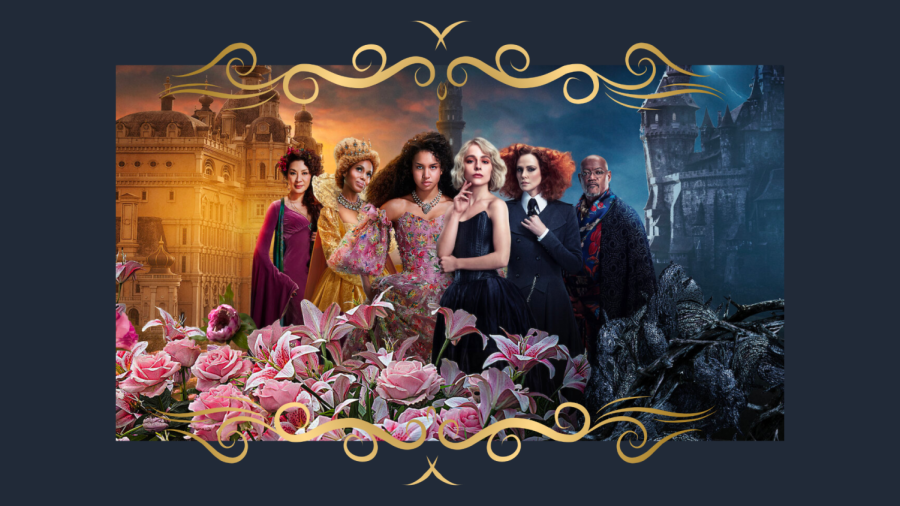Film Review: “The School for Good and Evil” fizzles in enchantment
“Ever After High” meets “Harry Potter” in a highly-anticipated adaptation that is more flat than fantastical
Directed by Paul Fieg, “The School for Good and Evil” suffers from a cliched script that fails to develop most of its characters. The film tries to cram too much into an already lengthy viewing time (2 hours 27 minutes), a sign that the books would likely have been better adapted instead as a television series to flesh out all the subplots and characters. (Image courtesy of Netflix)
Hollywood has long turned to traditional fairy tales to weave new stories with modern twists, from “Once Upon a Time” to Disney’s live action remakes of “Maleficent” and “Cruella.” The latest fairytale glow up is “The School for Good and Evil,” adapted from the first installment of the best-selling book series by Soman Chainani. An “Ever After High” meets “Harry Potter” story, the film’s worthy cast and strong potential is unfortunately let down by a lacking script, overwhelming visuals, and flat characters.
We begin in the village of Gavaldon, where fellow outcasts Sophie (Sophia Anne Caruso) and Agatha (Sofia Wylie) are polar opposites, but best friends. Sophie, always pretty in pink, dreams of becoming a beloved princess, while Agatha’s dark academia attire and cat Reaper deems her a witch in the villagers’ eyes. After Sophie wishes to be whisked out of Galvadon for a more exciting life, both girls are kidnapped to the School for Good and Evil, a magical institution that trains the next generations of fairytale heroes and villains.
The twist? Their gnarled gargoyle captor drops them in the wrong schools: Sophie in the goth-like School of Evil, Agatha the blindingly pink School of Good. As the girls struggle to survive in their respective ‘wrong’ schools, they must preserve their friendship and find a way out together.
Caruso and Wylie, both making their feature film lead debuts, have undeniable chemistry as a duo, their scenes together being the movie’s best and most emotional. Caruso, in particular, gives a standout performance, playing Sophie with feisty charm and the perfect dose of histrionics. Despite Wylie’s best efforts, Agatha’s personal potential is limited by a drab script that erases her original character’s sullen sarcasm and aversion to social interactions, designating her as the Mary Sue.
While select side characters catch the eye–Briony Scarlett pulls off an impressive performance as princess mean girl Beatrice–they usually are a hit-or-miss. The film’s stellar cast, with the likes of Michelle Yeoh and Kerry Washington, aren’t given enough opportunities to show their chops, and other characters are portrayed in one-dimensional, often exaggerated, caricatures. And let us not mention forgettable love interest Prince Tedros (Jaime Flatters), who delivers more bewildered man-child than charismatic hunk.
When it comes to visual effects, “The School for Good and Evil” disappoints. For a story based on magic, the spells and mystical creatures fail to immerse and captivate. Instead, the primary villain’s cursed blood magic looks like animated splatters of paint, and CGI-animated guard wolves appear jarringly fake.
The film makes a commended effort to make its viewers consider deeper questions: is one inherently good or evil? Can people control their own fate? But at these times, characters morph into criticism-spewing vessels through which the film tries to impart (very unsubtle) moral messages about prejudice, stereotypes, and true beauty. Agatha declares that no one is “truly good or truly evil, because people are complicated,” one professor decries how the school became “insufferably shallow,” and another instructor criticizes the current “age of self-centered perfectionism.” While the result might be too blatant and on-the-nose, the force-feeding perhaps is necessary to break through a barrage of flamboyant costumes, over-the-top set designs, and an angsty teen soundtrack featuring Billie Eilish and Olivia Rodrigo.
Various characters throughout the film emphasize that “it’s not what we are, it’s what we do.” It’s as if they’re sending a silent plea to be judged by what they aspire to accomplish–defying stereotypes, empowering strong female friendships, perhaps becoming the next lucrative movie series–instead of what “The School for Good and Evil” actually is: a lackluster happily never after that lets down the promising magic of its source material.
Your donation will support the student journalists in the AVJournalism program. Your contribution will allow us to purchase equipment and cover our annual website hosting costs.

